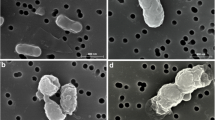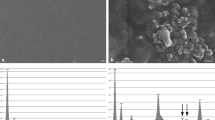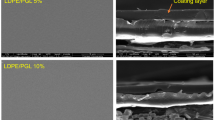Abstract
Antimicrobial packaging can be considered an extremely challenging technology that could have a significant impact on shelf-life extension and food safety of fresh meat and meat products. In this study, different commercial polyethylene films differing in vinyl acetate ethylene, erucamide contents, and oxygen permeability were used for the coating treatment with a nisin-based antimicrobial solution (NS). Detection and measurement of the activity of the NS was determined against different food spoilage bacteria. NS was then spread manually on food contact layer of different plastic films using coating rods providing thickness of 6, 40, 60, and 100 μm. The polyethylene films before and after treatment were analysed by atomic force microscopy (AFM). NS was active against Gram-positive bacteria and the best activity was obtained against Brochothrix thermosphacta. Viable staining and epifluorescence microscopy analysis of indicator strains in contact with activated plastic films showed that the effect of the film on the various indicator strains changed very much on the basis of both type of film and indicator strain. The highest numbers of lysed cells were shown by two polyethylene films that, according to the AFM and roughness parameters analyses, were characterized by significant increase or decrease of roughness after the coating treatment. AFM analysis showed that the homogeneity of the coating was much influenced by the type of plastic films used. In order to test the efficacy in food, portions of beef chuck tender slices were prepared and covered with the antimicrobial plastic films on both sides. After 1 h and 1, 7, and 12 days of storage at 4 °C the meat samples were analyzed by standard plate counting targeting spoilage associated microbial populations. The antimicrobial plastic films after 1 h of contact with the meat caused a significant reduction of lactic acid bacteria and B. thermosphacta. The most effective antimicrobial activity of films was shown against the same populations after 24 h of storage.



Similar content being viewed by others
References
Bastarrachea, L., Dhawan, S., & Sablani, S. (2011). Engineering properties of polymeric-based antimicrobial films for food packaging. Food Engineering Reviews, 3(2), 79–93.
Coma, V., Sebti, I., Pardon, P., Deschamps, A., & Pichavant, F. H. (2001). Antimicrobial edible packaging based on cellulosic ethers, fatty acids, and nisin incorporation to inhibit Listeria innocua and Staphylococcus aureus. Journal of Food Protection, 64(4), 470–475.
Cutter, C. N., Willett, J. L., & Siragusa, G. R. (2001). Improved antimicrobial activity of nisin-incorporated polymer films by formulation change and addition of food grade chelator. Letters in Applied Microbiology, 33(4), 325–328.
Dawson, P. L., Hirt, D. E., Rieck, J. R., Acton, J. C., & Sotthibandhu, A. (2003). Nisin release from films is affected by both protein type and film-forming method. Food Research International, 36(9–10), 959–968.
Ercolini, D., La Storia, A., Villani, F., & Mauriello, G. (2006). Effect of a bacteriocin activated polyethylene film on Listeria monocytogenes as evaluated by viable staining and epifluorescence microscopy. Journal of Applied Microbiology, 100(4), 765–772.
Ercolini, D., Russo, F., Nasi, A., Ferranti, P., & Villani, F. (2009). Mesophilic and psychrotrophic bacteria from meat and their spoilage potential in vitro and in beef. Applied and Environmental Microbiology, 75(7), 1990–2001.
Ercolini, D., Ferrocino, I., La Storia, A., Mauriello, G., Gigli, S., & Villani, F. (2010). Development of spoilage microbiota in beef stored in nisin activated packaging. Food Microbiology, 27(1), 137–143.
Ercolini, D., Ferrocino, I., Nasi, A., Ndagijimana, M., Vernocchi, P., La Storia, A., Laghi, L., Mauriello, G., Guerzoni, M. E., & Villani, F. (2011). Monitoring of microbial metabolites and bacterial diversity in beef stored under different packaging conditions. Applied and Environmental Microbiology, 77(20), 7372–7381.
European Commission (2009). Commission Regulation (EC) No 450/2009 of 29 May 2009 on active and intelligent materials and articles intended to come into contact with food. Official Journal of the European Union, Brussels, Belgium. http://eurlex.europa.eu/LexUriServ/LexUriServ.do?uri=OJ:L:2009:135:0003:0011:en:pdf.2009/450/EC
Gálvez, A., Abriouel, H., López, R. L., & Omar, N. B. (2007). Bacteriocin-based strategies for food biopreservation. International Journal of Food Microbiology, 120(1–2), 51–70.
Gill, A. O., & Holley, R. A. (2000). Inhibition of bacterial growth on hamand Bologna by lysozyme, nisin and EDTA. Food Research International, 33(2), 83–90.
Gill, A. O., & Holley, R. A. (2003). Interactive inhibition of meat spoilage and pathogenic bacteria by lysozyme, nisin and EDTA in the presence of nitrite and sodium chloride at 24 °C. International Journal of Food Microbiology, 80(3), 251–259.
Holzapfel, W. H., Geisen, R., & Schillinger, U. (1995). Biological preservation of foods with reference to protective cultures, bacteriocins and food-grade enzymes. International Journal of Food Microbiology, 24(3), 343–362.
Kirwan, M. J., & Strawbridge, J. W. (2003). Plastics in food packaging. In R. Coles, D. McDowell, & M. J. Kirwan (Eds.), Food packaging technology (pp. 174–240). London: Blackwell Publishing Ltd.
La Storia, A., Ercolini, D., Marinello, F., & Mauriello, G. (2008). Characterization of bacteriocin coated antimicrobial polyethylene films by atomic force microscopy. Journal of Food Science, 73(4), 48–54.
La Storia, A., Ercolini, D., Di Pasqua, R., Villani, F., Marinello, F., & Mauriello, G. (2011). Atomic force microscopy analysis shows surface structure changes in carvacrol-treated bacterial cells. Research in Microbiology, 162(2), 164–172.
Martinez-Viedma, P., Ercolini, D., Ferrocino, I., Abriouel, H., Ben Omar, N., Lopez, R. L., & Galvez, A. (2010). Effect of polythene film activated with enterocin EJ97 in combination with EDTA against Bacillus coagulans. LWT- Food Science and Technology, 43(3), 514–518.
Mauriello, G., Ercolini, D., La Storia, A., Casaburi, A., & Villani, F. (2004). Development of polyethylene films for food packaging activated with an antilisterial bacteriocin from Lactobacillus curvatus 32Y. Journal of Applied Microbiology, 97(2), 314–322.
Natrajan, N., & Sheldon, B. W. (2000). Efficacy of nisin-coated polymer films to inactivate Salmonella typhimurium on fresh broiler skin. Journal of Food Protection, 63(9), 1189–1196.
Nattress, F. M., Yost, C. K., & Baker, L. P. (2001). Evaluation of the ability of lysozyme and nisin to control meat spoilage bacteria. International Journal of Food Microbiology, 70(1–2), 111–119.
Neetoo, H., Ye, Mu, & Chen, H. (2007). Effectiveness and stability of plastic films coated with nisin for inhibition of Listeria monocytogenes. Journal of Food Protection, 70, 1267–1271.
Nostro, A., Scaffaro, R., Ginestra, G., D’Arrigo, M., Botta, L., Marino, A., & Bisignano, G. (2010). Control of biofilm formation by poly-ethylene-co-vinyl acetate films incorporating nisin. Applied Microbiology and Biotechnology, 87(2), 729–737.
Nychas, G.-J. E., Skandamis, P. N., Tassou, C. C., & Koutsoumanis, K. P. (2008). Meat spoilage during distribution. Meat Science, 78(1–2), 77–89.
Pérez-Pérez, C., Regalado-González, C., Rodríguez-Rodríguez, C. A., Barbosa-Rodríguez, J. R., & Villaseñor-Ortega, F. (2006). Incorporation of antimicrobial agents in food packaging films and coatings. In R. G. Guevara-González, & I. Torres-Pacheco (Eds.), Advances in agricultural and food biotechnology (193–216). Kerala: Research Signpost.
Razavi-Rohani, S. M., & Griffiths, M. W. (1994). The effect of mono and polyglycerol laurate on spoilage and pathogenic bacteria associated with foods. Journal of Food Safety, 14(2), 131–151.
Reunanen, J., & Saris, P. E. J. (2004). Bioassay for nisin in sausage; a shelf life study of nisin in cooked sausage. Meat Science, 66(3), 515–518.
Robertson, G. L. (2006). Food packaging: principles and practice, 2nd edition. Fla: Taylor & Francis, Boca Raton.
Rose, N. L., Sporns, P., Stiles, M. E., & McMullen, L. M. (1999). Inactivation of nisin by glutathione in fresh meat. Journal of Food Science, 64(5), 759–762.
Scannell, A. G. M., Hill, C., Ross, R. P., Marx, S., Hartmeier, W., & Arendt, E. K. (2000). Development of bioactive food packaging materials using immobilized bacteriocins Lacticin 3147 and Nisaplin. International Journal of Food Microbiology, 60(2–3), 241–249.
Sofos, J. N., Beuchat, L. R., Davidson, P. M., & Johnson, E. A. (1998). Naturally occurring antimicrobials in food. Regulatory Toxicology and Pharmacology, 28(2), 71–72.
Stevens, K. A., Sheldon, B. W., Klapes, N. A., & Klaenhammer, T. R. (1991). Nisin treatment for inactivation of Salmonella species and other Gram-negative bacteria. Applied and Environmental Microbiology, 57(12), 3613–3615.
Suppakul, P., Miltz, J., Sonneveld, K., & Bigger, S. W. (2003). Active packaging technologies with an emphasis on antimicrobial packaging and its applications. Journal of Food Science, 68(2), 408–420.
Tant, M. R., Mauritz, K. A. & Wilker, G. L. (1997). Ionomers: synthesis, structure, properties and applications. London: Blackie Academic & Professional.
Tu, L., & Mustapha, A. (2002). Reduction of Brochothrix thermosphacta and Salmonella serotype typhimurium on vacuum-packaged fresh beef treated with nisin and nisin combined with EDTA. Journal of Food Science, 67(1), 302–306.
Villani, F., Pepe, O., Mauriello, G., Salzano, G., Moschetti, G., & Coppola, S. (1994). Antimicrobial activity of Staphylococcus xylosus from Italian sausage against Listeria monocytogenes. Letters in Applied Microbiology, 18(3), 159–161.
Willey, J. M., & van der Donk, W. A. (2007). Lantibiotics: peptides of diverse structure and function. Annual Review of Microbiology, 61, 477–501.
Zhou, G. H., Xu, X. L., & Liu, Y. (2010). Preservation technologies for fresh meat—a review. Meat Science, 86(1), 119–128.
Source of support
This study was partly supported by a EU project (SYMBIOSIS-EU) within the 7th Framework Programme (ref. Grant agreement N°. 211638). A. La Storia was also supported by the Montana award 2009.
Author information
Authors and Affiliations
Corresponding author
Rights and permissions
About this article
Cite this article
La Storia, A., Mauriello, G., Villani, F. et al. Coating-Activation and Antimicrobial Efficacy of Different Polyethylene Films with a Nisin-Based Solution. Food Bioprocess Technol 6, 2770–2779 (2013). https://doi.org/10.1007/s11947-012-0902-x
Received:
Accepted:
Published:
Issue Date:
DOI: https://doi.org/10.1007/s11947-012-0902-x




